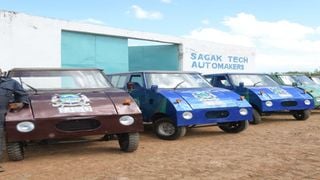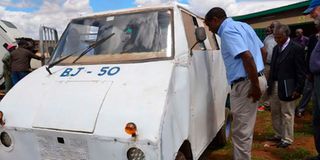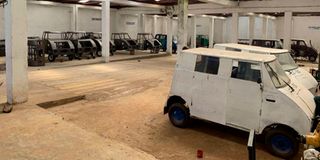
The BJ-50 vehicles manufactured in Laikipia.
| File | James Murimi | Nation Media GroupDN2
Premium
Behind the wheel of the BJ50, the ambitious tuktuk of Nyahururu
Sagak Tech Automakers is best described as a shed on the outskirts of Nyahururu town, just off the road to Ol Joro Orok. The company is the result of an ambitious man’s quest to provide cheap and versatile mobility to the denizens of Laikipia County. Mark these words because they have an important role to play in later discussions.
The path he chose towards this mobility is called the BJ50, and it is important that we define exactly what the BJ50 is... or is not. It is NOT a car, this much was pressed upon me. It turns out I’m a much better listener than the bureau of standards, which repeatedly failed the BJ50 during testing for qualification and ultimate approval, because the test regime used was for motor vehicles and not rickshaws. The BJ50 is a rickshaw, or what Mombasa people refer to as bajaji (Bajaj), more commonly known to us bara people as a tuktuk.
It took several efforts and a lot of back and forth before the company finally received approval from the National Transport and Safety Authority for the BJ50 to be allowed for public road use. Once we got this news, Bernard Mwinzi, a friend and the creator of my Wednesday column in the Daily Nation, suggested we take a drive and see what exactly the NTSA had approved. There were no surprises here, this is the age of social media and instant news, so we already knew what the vehicle looked like and where it was built. What I was not ready for is how it drives.
Or the price tag. This tuktuk is selling for Sh450,000. The proprietor says 10 of them have already been paid for even before they leave the assembly line, but that price tag appears steep. Maybe automation and the resultant economies of scale will bring down the cost of production and, with it, the cost of the tuktuk. Maybe. But for now, Sh450,000 it is.
What it’s like
Let’s not mince words here; you get exactly what you see, which is build quality that can most diplomatically be described as “subpar”. The fit and finish is not good by any measurement, the stance is awkward and the looks are unfortunate. You take a short walk around it — and it will be a short walk since this is a tiny vehicle — take in the crudeness of the assembly, then yank open the sheet iron panel that passes for a door to install yourself into the most uncomfortable driving position ever.
You undergo a quick familiarisation course. You are shown the gauges (also taken off a tuktuk) which include a speedometer that goes up to 80km/h (an attainable terminal velocity, they claimed) and a digital readout showing what gear you are in except neutral and reverse. Neutral is marked by a green light, reverse is indicated by the direction you will take once you get the thing moving.

Laikipia County Governor Ndiritu Muriithi admires a BJ-50 vehicle.
To get it moving, you have an ignition key directly below the steering column, which is the first key difference between the BJ50 and a bajaji. The BJ50 has a circular steering wheel at the top of the tiller tower as opposed to the handlebars used in regular rickshaws. The wheel itself is small, which is odd for something without power assistance; but then again the BJ50 is very light and has tiny, narrow wheels, so not much effort is required to get it to turn, which is fine. What is not fine is the lopsided mounting of the wheel where the right hemisphere is noticeable lower than the left. Hmm.
Another key difference between the BJ50 and a tuktuk lies at your feet. You have three pedals, like in a regular manual car, and the layout is normal industry standard: throttle on the right, brake in the middle, clutch on the left. So far, so good. Then you get to the middle of the cockpit and what assaults you is straight out of the control room of a bulldozer: there are four levers of varying lengths pointing at the roof. What are these?
The longest one, which is also the one closest to your left knee, is the handbrake. Disengaging it is fairly easy, but engaging it is an introductory course into the finer details of tactile feedback. It just floats around in its housing moving up and down doing nothing, until you have the brake pedal firmly depressed — the operative word here being firmly — then you have to angle it slightly away from you and shove it decisively into position until you feel like something has engaged. Then you gingerly release the brake pedal to see if the BJ50 will start rolling away. If it does it means you failed and have to try again. If it doesn’t, it means the parking brake is engaged.
Next to the parking brake is the shortest gear lever of the lot, and this one selects between reverse and forward. This kind of layout usually indicates one thing: the vehicle is as fast going forward as it is going backward. It has the same number of gears in reverse as it does forward. This places the BJ50 in a unique class that not even Mercedes-Benz with its overcomplicated 7G-Tronic automatic transmission can match. The 7G-Tronic has two reverse gears. The Bj50 might have five reverse gears.
Third from the right is also the third tallest gear lever; and that is the range selector that allows you to choose between high and low. The instructor said something that sounded the opposite of what I’m used to but since this was never clarified, I will not repeat it here for fear of spreading disinformation. I have no idea what position it was in and I wisely decided to leave it where it was since I wanted to test the vehicle in its “default” setting. Further experimentation will come with future test drives; and there will be future test drives.

The BJ-50 vehicles garage in Laikipia.
The leftmost gear lever is the piece de resistance, the actual gear selector, and it is straight out of a racecar. It controls a sequential transmission, the kind which my car modification crowd can only dream of installing in their Subaru Evolution GTI Type Rs. You start off in neutral and tap the gear lever forward to go into first. Tap it forward again to go into second and repeat the process all the way into fifth. Yes, the BJ50 comes with a five-speed sequential transmission. This is what automotive wet dreams are made of. To downshift, just yank the lever backwards all the way from whatever gear you are in into neutral.
To get to the Sagak Tech assembly, I had with me a Mazda CX-30 that I also happened to be test driving at the time. It comes with a six-speed automatic transmission with manual override or what we call “tiptronic”. The shift pattern here is the reverse of the BJ50, you push it forward to downshift and pull it backward to shift up. This is also the same setup used in the sequential boxes for racecars because the pulling back simulates the shift in an H-pattern from first into second, and the pushing up simulates the downshift from fourth into third. So perhaps, apart from the sequential technology, the BJ50 is less of a racecar than the Mazda. But that’s because the BJ50 is a rickshaw, not a car.
To go into reverse, make use of that short gear lever. Like the handbrake and unlike the main gear selector, it too floats around indecisively and you will know what position it is in if one of three things happens: 1) the vehicle moves forward (reverse not selected), 2) the vehicle revs noisily in place (nothing is engaged), or, 3) the vehicle moves backwards (success). But before any of this happens, you first have to come to a stop, yank the gear lever until the light goes green (neutral), then push the short lever as far forward as you can, clutch in, select first gear, then declutch. You should go backwards, and you should be able to gear up in reverse until you are doing 80km/h backwards, something I strongly recommend NOT to do.
Lesson over, let’s drive
Driving it
From my very uncomfortable driving position — the cockpit is cramped, and the seating position is the one you adopt when perched on a very small stool holding a tea tray close to your chest — I am able to reach everything without leaning, including the passenger door. There is no seat belt. Right foot on brake, left foot clutching in hard as I can until my shin starts to ache, then turn the key. The 250cc water-cooled single cylinder engine fires up shakily. I typically select first gear before disengaging the handbrake, but this time, I first disengaged the handbrake before selecting first.
First selected, now to declutch gently, and I stall the engine.
Okaaaay!
Yank the lever back into neutral, fire up the engine again, push into first, build the revs a bit and declutch gingerly, and I stall again.
Then I stall a third time. The instructor snarkily remarks that drivers of automatic cars have problems when accosted with a manual. I want to say, but I don’t: “Listen here, buster, my daily is a manual BMW 525i with ten times the engine size and six times the cylinder count of your tuktuk with probably 1,000 times the torque, so watch your words and don’t go gabbling about my ineptitude at clutch control. I am good with a manual.”
And that, there, was the problem. When you daily-drive a manual straight six German with enough torque to do a hill start in second gear, jumping into a single-cylinder calls for an adjustment in technique. I can get my BMW moving on a closed throttle; to get the BJ50 moving, you have to give it the beans; and give it the beans properly. Rev it until the valves threaten to poke holes into the bodywork as they escape the torment you are subjecting the engine to, then declutch and you are off.

The pick-up version of the Sagak BJ50 is designed to carry five tonnes.
Roll of the line, stomp the clutch, punch the gear lever forward, and you are in second. Progress. Repeat the process into third then fourth, and we are ambling along nicely... and I do mean nicely. Despite the poor looks, the shoddy build, intolerable NVH (noise, vibration and harshness) and non-existent optimisation of the suspension, the BJ50 is actually fun to drive. There is a certain joy in operating a noisy little machine with a sequential transmission, and once I joined the highway I very quickly got to 60km/h. It wanders all over the road and the steering won’t self-correct after making turns (watch out there now), but it is very easy to adapt to the rickshaw.
There is plenty wrong with it, which just adds to its quirkiness. Besides the list above, the blind spots are massive, the mirrors are useless, the pedal operation is non-linear across the board, meaning that we have a submenu for this list: certain operations lack finesse such as clutch control (the vehicle hops with every gear change), brake modulation (touch the pedal and nothing happens, apply a little more pressure and the BJ50 skids to an unceremonious halt) and throttle-on throttle-off interchanges means lingering revs during gear changes and surging at the start of engine braking. These are just teething problems that can be ironed out during the tuning phase, if such a phase exists. Why would it not exist?
Now, making a motorised vehicle is not easy, even simply assembling one from pre-existing components, let alone building it from scratch. You need a lot of scratch to do this with a semblance of success, and the founder of Sagak Tech found this out very quickly after he started actualising his vision.
But a man on a mission is not to be stopped if he is committed. His resilience and insistence of going forward with the project ended up attracting the attention of the county government, which, after much deliberation, decided to heavily invest in the enterprise. County governments are led by governors, and one day after my dramatic drive in the BJ50 in Nyahururu, I found myself seated in a plush Nanyuki office across from one very interesting gentleman, His Excellency Ndiritu Muriithi, the governor of Laikipia County. He had a lot to say, and I must admit, the man is very convincing.
Theory of Change
The Navigation Acts of 1651 were a series of protectionist laws drafted to promote, develop and regulate English shipping, trade and commerce between other countries and its own colonies, mostly by restricting the participation of outsiders in its colonial trade. These restrictions included prohibition of the use of foreign ships and the exportation of specific products to countries other than Britain and its colonies, as well as requiring the employment of an English workforce, with the colonial shipping vessels (including East India Company ships) being mandated to have a minimum English crew of 75 per cent.
The laws are a reflection of the European mercantilism economic theory which aimed to maintain all trade benefits within their respective empires and minimise the loss of precious metals and profits to foreigners through trade. This is the mindset that Mr Muriithi adopted when his county government decided to back the Sagak Tech BJ50 rickshaw, and thinking about it, he does have a point.
The existence of the BJ50 is a clear indication that his county can actually build a motorised vehicle, so why should they import them? Why send their hard-earned money to Europe or Asia when they can buy the same product from each other and keep the cash flow within the sovereign boundaries of the county of Laikipia (and possibly Nyandarua, which is only a few meters away from the Sagak Tech factory)?
There is a reason the geo-economic question is county-specific: the man is not blind. He is well aware of the negative reception that the BJ50 has been receiving, and frankly he doesn’t give two hoots about it. His own charges in the county have accepted the project, and his main responsibility is towards THEM. You gon’ learn.
Do not confuse this reaction with arrogance; far from it. Mr Ndiritu has his eyes on the prize and social media noise is not going to be an impediment. A sumptuous roast starts with a dangerous hunt and a tedious collection of firewood. If the guests who partake of the roast are privy to the preparatory tasks involved, perhaps they will be less acerbic about the bloodstains on the kitchen floor or the stench of tripe when the belly of the beast is ripped open during slaughter. This is my own analogy and perhaps I should explain what I’m talking about.
Between Sagak Tech, the County government of Laikipia, the residents and their leader, what we have here is a replay of the Navigation Acts of 1651 but on a smaller scale. Sagak Tech may claim whatever fancy reasons for building the BJ50, but ultimately any automaker is after profit.
Sagak Tech has also achieved something priceless: it has definitely put Laikipia County on the map, and everyone has taken notice. The only way from here is up.
I get them, which is why I will not trash the BJ50. Instead I will support it. Don’t get me wrong: I am not trying to sanitise mediocrity and I am not an apologist for well-intentioned but half-baked undertakings, and I am definitely not brown-nosing a county governor. The BJ50 rickshaw is far from complete and it needs a lot of work, which is why I, too, am asking the same question that everyone else has been: how on earth did the vehicle get NTSA approval for use on public roads?
Yes, the aesthetics are terrible, but there is no test for aesthetics since looks are subjective, so that is a non-issue. However, the build quality could be better by far and the driving ergonomics need serious improvement for the safety of everyone.
I am throwing in with the project. Followers of my writings in both the Daily Nation and The EastAfrican are aware of my relationship with Mobius Motors. I was critical of their cars and their direction, and they in turn wanted nothing to do with me. I gave some recommendations on how to proceed if they want to succeed in the motoring industry back in 2016, and it took them five years to realise I was right.
In 2021, they released the Mobius 3, based on the exact same advice I gave: don't reinvent the wheel and don't try to rediscover fire; start with licensed assembly of an existing product, learn from it then develop your own product based on what you learn. You don't create a mobile app by reinventing the telephone or rediscovering electricity.
Will Sagak Tech also wait five years to realise the value of this writer’s advice or will they engage immediately so as to achieve actualisation sooner? Let’s wait and see, but for now, go easy on them.





